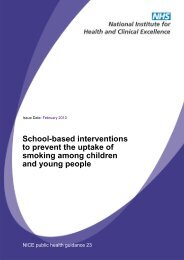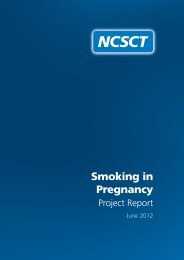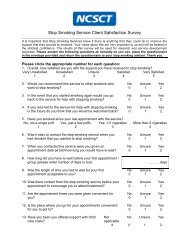Smoking and mental health - NCSCT
Smoking and mental health - NCSCT
Smoking and mental health - NCSCT
Create successful ePaper yourself
Turn your PDF publications into a flip-book with our unique Google optimized e-Paper software.
<strong>Smoking</strong> <strong>and</strong> <strong>mental</strong> <strong>health</strong><br />
guidelines. Young people in this study also reported that staff in residential care<br />
did not always take incidents of smoking seriously. Up to two-thirds of foster<br />
carers reported smoking in front of the children in their care, indicating that<br />
passive smoke exposure is also a significant risk for looked-after children. Other<br />
potential contributors include the reported low expectations of children in<br />
care, 181 particularly concerning education but perhaps extending to smoking as<br />
well. In crisis situations, <strong>and</strong> where placement moves are frequent, <strong>health</strong> matters<br />
may also take a lower priority. 182 Young people may miss out on <strong>health</strong><br />
promotion messages <strong>and</strong> <strong>health</strong>y lifestyle discussion due to school changes, or<br />
even due to being excluded from school. 183 These vulnerable children <strong>and</strong> young<br />
people, in terms of their <strong>mental</strong> <strong>health</strong> <strong>and</strong> smoking behaviour, are thus subject<br />
to a ‘double disadvantage’. They have already experienced considerable adversity<br />
before coming into care <strong>and</strong> can be further disadvantaged by the care system<br />
itself. Time for change, the 2007 White Paper, with the key theme being the<br />
importance of good corporate parenting, states that ‘the aspiration that the state<br />
has for these children should be no less than each parent would have for their<br />
own child’. 184<br />
7.6.5 <strong>Smoking</strong> prevention <strong>and</strong> cessation in children <strong>and</strong> adolescents with<br />
<strong>mental</strong> disorders <strong>and</strong> in looked-after children<br />
In addition to the wider efforts to prevent smoking uptake in young people<br />
generally, there is a clear need for services to address the high rates of smoking in<br />
these groups. The Royal College of Psychiatrists recommends ‘targeted<br />
approaches for children <strong>and</strong> adolescents with emotional <strong>and</strong> behavioural<br />
disorder, who are at a much higher risk of taking up smoking’. 185 This may take<br />
place within child <strong>and</strong> adolescent <strong>mental</strong> <strong>health</strong> services (CAMHS), but means<br />
that staff working with young people with <strong>mental</strong> <strong>health</strong> problems need<br />
appropriate training <strong>and</strong> resources to offer brief intervention or signposting. 186<br />
British studies are lacking, but one US study of child <strong>and</strong> adolescent psychiatrists<br />
found that the majority did not give consistent messages about smoking, <strong>and</strong><br />
highlighted the need for more formal training. 187 Some <strong>mental</strong> <strong>health</strong> problems<br />
may be open to specific approaches, eg it has been suggested that<br />
‘pharmacological treatment of ADHD before children are exposed to cigarettes<br />
may protect against smoking’. 171 NICE has produced guidance on smoking<br />
cessation services in general 186 <strong>and</strong> is due to publish guidance in 2013 on<br />
smoking cessation in secondary care <strong>mental</strong> <strong>health</strong> services; however, further<br />
research into what works is still needed.<br />
There have been efforts to address the <strong>mental</strong> <strong>health</strong> needs of looked-after<br />
children through dedicated CAMHS teams <strong>and</strong> <strong>mental</strong> <strong>health</strong> screening.<br />
Similarly, there has been a movement to target smoking in this group in<br />
particular, eg by employing a looked-after children’s smoking cessation adviser to<br />
work with young people, foster carers, social workers <strong>and</strong> residential staff. 188 In<br />
152 © Royal College of Physicians 2013














